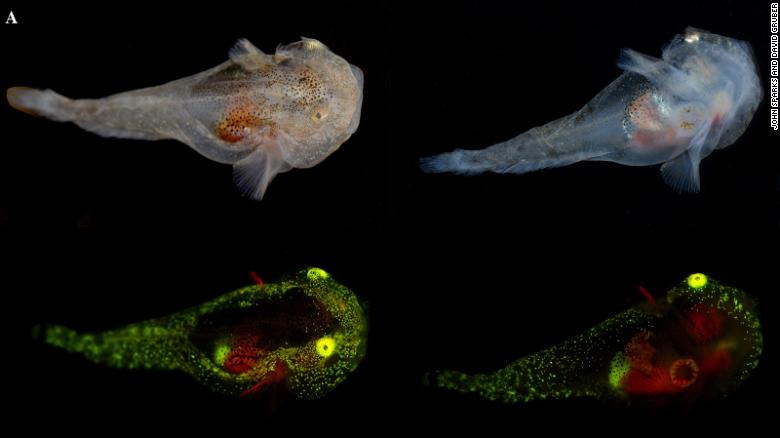Glowing Fish That Produce Antifreeze Discovered in the Arctic
Scientists have discovered a glowing snailfish in the Arctic full of naturally occurring antifreeze proteins that help it survive in subzero waters.
"Similar to how antifreeze in your car keeps the water in your radiator from freezing in cold temperatures, some animals have evolved amazing machinery that prevent them from freezing, such as antifreeze proteins, which prevent ice crystals from forming," said David Gruber, a co-author of a recently published academic paper about the fish.
Gruber and co-author John Sparks, both research scientists at the American Museum of Natural History, first spotted a glowing snailfish in 2019 on a scientific expedition off the coast of East Greenland.
The researchers collected a three-quarter-inch juvenile snailfish (about the size of a fingernail) to study its bioluminescent properties. This adaptation—which allows animals to convert blue light into green, red, or yellow light—is incredibly rare in Arctic fish, which live in extended periods of darkness. The snailfish is the only known polar fish with bioluminescent properties.
This specimen taught the team that bioluminescence isn’t the only special thing about the snailfish: it has the highest expression levels of antifreeze proteins ever observed, a task that likely requires much of the fish’s energy.
"We see that in addition to growth, this juvenile fish must also invest heavily in protecting itself from freezing," says co-author John Burns, a senior research scientist at Maine’s Bigelow Laboratory for Ocean Sciences. "The amount of RNA the fish is making for protection from freezing is on par with what it invests in fundamental cellular machinery, the stuff that makes its cells in the first place."
The snailfish actually has two different types of gene families that encode the antifreeze proteins: type I and type IV.
"The genes coding for type I antifreeze proteins are likely recent additions to the fish genome and may be actively expanding to additional copies," Burns said. "It's like catching evolution in action."
Scientists first discovered antifreeze proteins in fish nearly 50 years ago. Produced primarily in the liver, these proteins prevent large ice grains from forming in the fish’s cells and body fluids. Unlike some insects and reptiles, fish cannot survive even partial freezing of their body fluids.
Some scientists predict that if Arctic sea ice continues to decline at current rates, the Arctic will be ice-free within 30 years, the study authors wrote. Animals like the snailfish are adapted to live in freezing temperatures and frigid waters. Therefore, warming Arctic temperatures due to climate change could pose a threat to their continued existence because all the energy they exert for thermal protection is wasted effort, Burns explains.
"Arctic seas do not support a high diversity of fish species, and our study hypothesizes that with increasingly warming oceanic temperatures, ice-dwelling specialists such as this snailfish may encounter increased competition by more temperate species that were previously unable to survive at these higher northern latitudes," says Sparks.

When you subscribe to the blog, we will send you an e-mail when there are new updates on the site so you wouldn't miss them.
